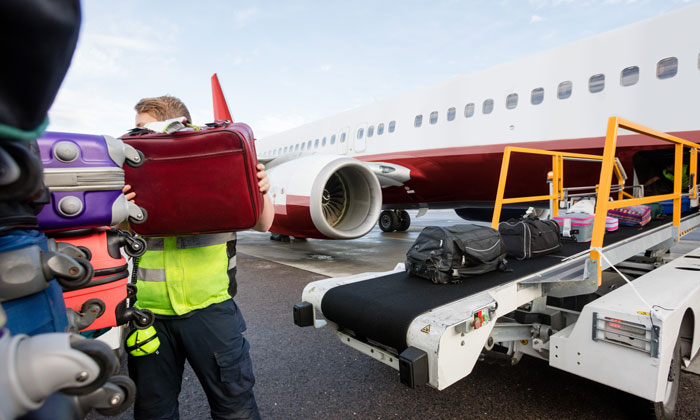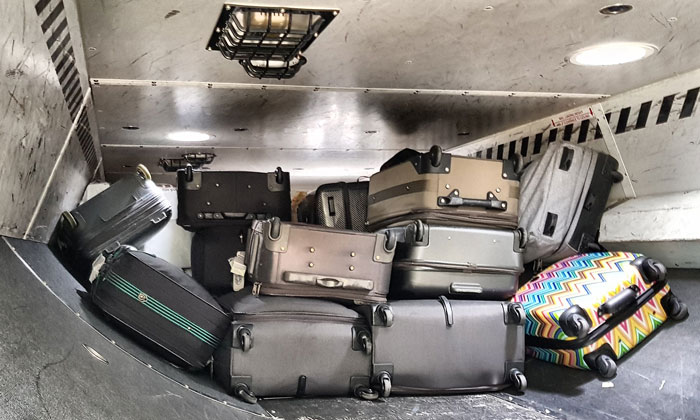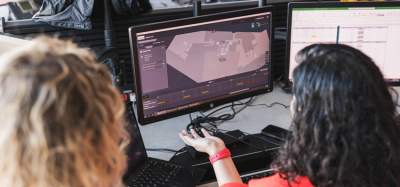Baggage handlers: The unsung heroes?
- Like
- Digg
- Del
- Tumblr
- VKontakte
- Buffer
- Love This
- Odnoklassniki
- Meneame
- Blogger
- Amazon
- Yahoo Mail
- Gmail
- AOL
- Newsvine
- HackerNews
- Evernote
- MySpace
- Mail.ru
- Viadeo
- Line
- Comments
- Yummly
- SMS
- Viber
- Telegram
- Subscribe
- Skype
- Facebook Messenger
- Kakao
- LiveJournal
- Yammer
- Edgar
- Fintel
- Mix
- Instapaper
- Copy Link
Posted: 25 November 2017 | Ross Coppolo (IOSH) | No comments yet
Ross Coppolo, Chair – Aviation & Aerospace Group – Institution of Occupational Safety & Health1, considers the health and safety challenges that baggage handlers experience and what more can be done to improve standards.


You will see baggage handlers working at airports worldwide. They carry out tasks that include processing and handling baggage during aircraft turnaround,
moving and operating ground service equipment and collecting, transporting and delivering hold baggage in both departures and arrivals.
They play an important role in keeping general day-to-day aerodrome operations working efficiently and effectively. Without these processes, airport and airline operations would quickly come to a halt, resulting in significant delays and disruption.
Furthermore, they are unsung heroes. Why? Firstly, baggage handlers are always present whenever an airport is open including during adverse weather conditions when there are sometimes very high or low temperatures, storm force winds or even the occasional thunderstorm. The typical baggage handler often works long shift patterns and under considerable pressure when aircraft are delayed or on short turnarounds.
It is worthwhile considering one of the key responsibilities placed upon baggage handlers. Loading hold baggage or freight in the wrong hold or location on an aircraft could significantly affect an aircraft’s centre of gravity, ultimately influencing how it will behave in flight.
What are the risks?
The latest UK Health and Safety Executive (HSE) statistics for the air transport industry report that just under 40 per cent of all injuries are caused by lifting and handling. This figure does not appear to be reducing, with the majority of lifting and handling injuries reported continuing to involve ground handling activities.
The main risk factors associated with baggage handling where regular lifting and handling take place continue to include the following:
- Pushing, pulling and moving hold baggage in the aircraft hold
- Moving equipment on the apron and inside baggage handling facilities without mechanical assistance
- Frequently handling bags at high and very low level, increasing the strain on key parts of the body including the neck, shoulders and lower back
- Handling bags weighing 20kg or more.
The risks from regular lifting and handling are exacerbated further when baggage handlers are required to work inside the holds of narrow-bodied aircraft, as the space is usually smaller and more confined than other aircraft.
This often results in baggage handlers having to sit or kneel while pushing, pulling and moving hold baggage, increasing the risk of injury.
The weight of hold baggage remains a continued challenge for the aviation industry and, more specifically, baggage handlers. This is especially the case when considering the hundreds of bags handled each day.
The current maximum hold baggage weight enforced by the majority of UK airlines is 23kg. Although a lot of work has been carried out over recent years through the HSE’s continued involvement with the airlines and ground handling companies – including successfully convincing the International Air Transport Association (IATA) to introduce and subsequently reduce the maximum weight of hold baggage – there remains opportunities and an obvious need to further reduce the maximum weight of hold baggage.
The general environment in which baggage handlers operate can sometimes be hostile. The apron area and, more specifically, aircraft stand, are regularly congested with ground service equipment, baggage and in-flight catering vehicles and fuellers who are all competing for space within the confines of a stand. There is added complexity and pressure during short aircraft turnarounds.
Take into account the extreme temperatures; icy and wet conditions; low or poor lighting conditions; high noise levels from hold baggage systems, ground service equipment, adjacent aircraft taxiing onto stand and aircraft auxiliary power units operating on stand, and it is understandable why baggage handlers’ health could be adversely impacted – particularly if the correct control measures are not implemented, such as using the correct personal protective
equipment. However, this is viewed as a last resort when applying the general hierarchy of control.
Baggage handlers are also required to work at height, particularly when accessing the holds of larger aircraft – which can be situated several metres from the ground – while operating high loader equipment and when working from the back of flatbed baggage vehicles.
A number of successful initiatives have been achieved in recent years to address work at height issues. These include the installation of guard rails either side of belt loading equipment for when access is required to aircraft holds and the installation of guard rails on flatbed vehicles.
When ground service equipment is operated incorrectly, it presents several hazards and associated risks to baggage handlers. These include the risk of entrapment within moving parts and equipment, if set-up incorrectly, becoming unstable and potentially falling over.
The aviation industry is particularly reliant upon the training it provides employees in the safe systems of work to be adopted and followed when operating ground service equipment on the apron. There is currently no common minimum standard for training and it can vary significantly between companies.
Seasonal baggage handlers are sometimes only employed for a matter of weeks in order to cover or provide additional resource during peak times of the year. As a consequence there have been a number of accidents and incidents in recent years that have brought the provision of training and supervisory oversight for seasonal employees into question.


Aircraft holds should be made more accessible for baggage handlers
Making improvements
The question remains, as to what more can be done to improve health and safety standards for baggage handlers at airports?
Fundamental to improving the general environment that baggage handlers work in is for aircraft manufacturers, particularly those who produce narrow-bodied aircraft, to consider the design of aircraft holds with a view to making them more accessible and ergonomically friendly for baggage handlers to work in.
The latest aircraft are spectacles of efficiency, boasting sleek, ever elaborate designs that focus on extended range and enhancing the passenger experience.
However, I remain convinced that aircraft manufacturers could do more to consider baggage handlers and other individuals who work on aircraft, without compromising other aspects of aircraft design.
A number of industry-led initiatives, with the full support of agencies such as the HSE and CAA’s Ground Handling Operations Safety Team (GHOST), have improved general safety inside baggage handling areas.
There is then the question of health, which can sometimes be overlooked when it comes to general day-to-day activities. Or, in the event of an accident or incident, understanding whether there are underlying health issues that have influenced what has gone wrong and why.
Some companies have recognised that employees’ health is as important as their safety and consequently recruited occupational health advisers. There have also been initiatives such as offering immediate access to assess and treat musculoskeletal injuries, with the full support of physiotherapists.
There is also the risk of occupational cancer, as highlighted in IOSH’s ‘No Time to Lose’ campaign, which has showcased topics relevant to the aviation
industry, including the risks from exposure to solar radiation and diesel engine exhaust emissions.
It is important to note that a just culture is encouraged and implemented by the majority of companies operating in the aviation industry. However, there are still occasions where it would appear very easy to apportion responsibility at a baggage handler’s door without a full understanding of the causal and contributory factors of the occurrence.
It is the indirect factors that may have contributed to an accident that are sometimes overlooked, such as general fatigue, work shift patterns, the safety culture within an organisation, and other external influencing factors.
Is there a role for further automation? Some ground service equipment that previously required manual manoeuvring on the apron is now motorised, such as passenger steps. Meanwhile, newer technology has been introduced which includes more sophisticated extending belt loaders that transport hold baggage right into the aircraft hold. And there are now feasibility studies underway considering fully automated ground service equipment with the potential to operate during a typical aircraft turnaround without the need for human intervention.
For baggage handling facilities, Automated Storage and Retrieval Systems (ASRS) have been successfully introduced, such as the system installed at Amsterdam Schiphol Airport, which has resulted in up to 60 per cent of hold baggage processed in the airport’s South Hall being handled 24/7 by machines.
The general design of new hold baggage facilities comes under the requirements of the Construction (Design and Management) Regulations 2015 (CDM), which call for designers to consider from the outset the health and safety requirements of the end-user.
CDM has had a positive impact on the design of hold baggage facilities, particularly in relation to the design and provision of mechanical assistance and ergonomic design when assessing the compatibility between baggage handlers, ground service equipment and the hold baggage system itself.
There are always other options
What about a common standard for baggage handler training? There have been a number of discussions and proposals for a common standard for baggage handler training.
This could include a minimum baseline industry standard as a minimum and periodic refresher training for all handlers in the general safe baggage handling techniques. It could also feature task-specific training for baggage handling activities inside aircraft holds, job rotation awareness and general requirements
and the safe operation of mechanical handling equipment and other associated equipment. Mandatory periods of rest could also be considered in this training.
It is clear that progress has been made in improving health and safety standards for baggage handlers at airports. But a lot more could be done, particularly at the design stage of new aircraft types, ground service equipment and hold baggage system facilities, to reduce the number of lifting and handling injuries and the general health of baggage handlers.
After all, without them, airport and airline operations would quickly grind to a halt.




















